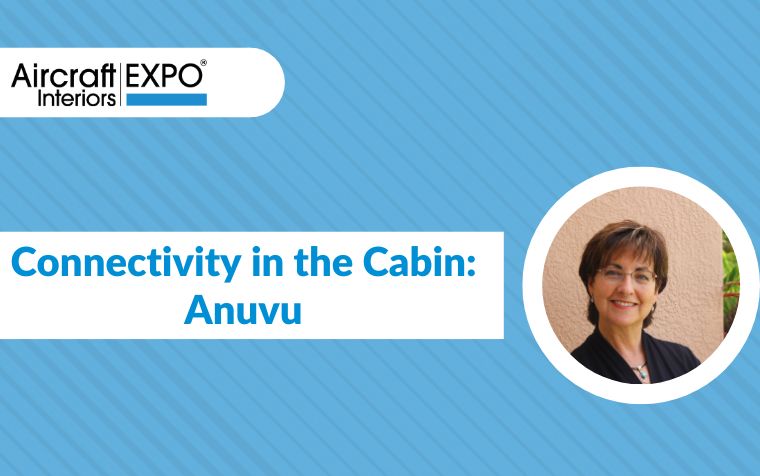The AIX team sat down with aerospace thought-leaders, market disruptors and established companies to discuss how Inflight Entertainment and Connectivity (IFEC) can keep up with changing passenger expectations.
The team spoke with Nancy Walker, Senior Vice President, Aviation Connectivity, Anuvu.
What are your predictions for connectivity in the cabin in 2023?
“Anuvu continues to see inflight customer activity moving towards applications requiring low latency and high return link throughput, across our mobility (maritime and inflight) customers.
We saw this trend years ago and we believe this will continue through 2023 and beyond. At one time, airlines thought the only thing that mattered for their customers was the ability to stream content, a relatively easy task to accomplish.
“Inflight connectivity solutions are an investment.”
Nancy Walker, Anuvu
Airlines are now seeing their customers’ demands migrate from streaming to include a heavy demand for the ability to work and collaborate in the cloud. Streaming content, tolerant of long latency times and very limited return links, is no longer the most demanding customer experience.
Cloud-based work and collaboration, which skyrocketed through the pandemic and continues unabated, is now demanding much more from connectivity suppliers. Airlines understand that solutions based only on streaming solutions and old GEO assets will not satisfy their customers’ needs going forward.
We also see a rapid convergence of connectivity and media content in the cabin, with airlines using their IFC systems to refresh content more often and to target advertising to their passengers.”
How do you see in-flight connectivity evolving in the next five years?
“Anuvu supports aviation, maritime and mobility markets exclusively. In 2023, we are seeing the maritime industry pivot to LEO networks and Anuvu is supporting this major market shift. Partnering with Starlink for maritime, Anuvu has embraced this market shift and works with customers to integrate multi-orbit solutions into their vessels.
We see this market shift starting in aviation and Anuvu stands ready to support airlines on this next chapter of aviation connectivity.
Airlines will continue to evaluate new LEO solutions coming to the market and to explore ways to adopt multi-orbit models—a pathway that Anuvu has long advocated. We offer a hybrid GEO-LEO solution today in the maritime market and we think airlines will increasingly press for flexible solutions that offer the best of both LEO and GEO satellites to provide a compelling mix of performance and economics for their IFC customer experience.
We don’t think connectivity customers will lock themselves in to closed architectures and will seek solutions that maintain optionality. We also believe that airlines will view connectivity as more than a passenger Wi-Fi offering and evaluate IFC solutions for a role in a variety of business objectives—targeted advertising, customer personalisation, cabin crew communications, and other functionality.”
Some estimations have put the “take-rate” for on-board Wi-Fi at just 6%, with some lamenting the poor connection and inability to stream content.
How do you see the role of Wi-Fi changing in the cabin going forward?
“At Anuvu, our experience shows that on-board Wi-Fi take rates depend on a wide variety of factors. These include other entertainment options available, offering of free messaging services, pricing of the Wi-Fi, ability to purchase Wi-Fi in the ticketing process, type of travelers (business or leisure), length of flight, day of week, type of connectivity required by the customer, and lastly on the expected performance of on-board Wi-Fi.
Take rates can vary wildly between 1% to upwards of over 60% on even the same airline dependent on the factors listed above. Anuvu systems support low to high throughput and take-rate demands always backed by a service level guarantee.
Anuvu has demonstrated over the last two decades our ability to customize our offering and work closely with our partner airlines to meet their expectations. Anuvu does not force any airline partner to fit their passenger experience to our business model – in fact, we do just the opposite.
With our connectivity, live television and our IFE offerings, we build unique solutions to allow airlines to control their interaction with their most valued assets – their passengers.
At Anuvu, we see passenger Wi-Fi and the outdated, “bring your own license” streaming-focused model as just one of multiple applications for airline connectivity. Aviation customers are increasingly exploring how inflight connectivity (IFC) and inflight entertainment (IFE) are converging and the many potential benefits this can offer an airline.

In addition to customising their interaction with their passengers, airlines are now using connectivity systems to bring fresh content and targeted advertising to their passengers. We’re also seeing gaming, retail and other connected entertainment services growing rapidly. Social media, accessed over smartphone apps, is the default entertainment for younger generations.
The convergence of IFC and IFE will also give airlines the ability to better understand their customer base and to curate content and other offerings via connected seatback screens and passenger devices. As airlines upgrade their connectivity systems to next-generation links, we’ll be able to open a new frontier in marketing, personalization, and targeting.
“The IFC market is entering an exciting period of growth and innovation.”
Nancy Walker, Anuvu
We believe that airlines will continue to use Wi-Fi as a brand differentiator and ancillary revenue source, depending on their brand and positioning in the market. Some carriers will offer IFC on a complimentary basis to all or a portion of their customers, while others will continue charging for it.”
The demand to stream content including on short and medium flights has proliferated.
How will airlines ensure they continue to meet this demand?
“Airlines make calculated financial and marketing decisions when assessing their IFC investments and their overall passenger experience. Airlines need to plan their expenditures today to ensure they can support their passengers’ IFC needs for the next decade.
Streaming tends to dominate discussions around inflight connectivity, as if it’s the most difficult application to support. In fact, it is the easiest.
Given that streaming does not require low latency nor heavy return-link throughput, the discussion shifts to how airlines will meet the needs of cloud-based collaboration and working demand proliferation.
When the conversation shifts to the future and doesn’t stay focused on the past, it is clear what the airlines need to do. Airlines must select a service provider with a long legacy of aviation connectivity and the ability to provide future solutions to their passengers. Inflight connectivity solutions are an investment that is most readily justified when it has the ability to support current and future demands and the inevitable shifts in technology to meet those demands.
Old fashioned GEO satellites have their place but lose when it comes to the ability to have a long life cycle with low total cost of ownership and service level guarantees that leave airlines in control.
Anuvu has prepared for the future and while we have seen GEO capacity growth for aviation, we are adding our own capacity in 2023 with the launch of the Anuvu Constellation.
These are smaller MicroGEO satellites to complement our leased capacity for airlines and maritime clients. Anuvu is also uniquely positioned as we are investing in solutions that support the push towards LEO.”
Any other comments or insight you would like to share around the topics of digitalisation and connectivity?
“The IFC market is entering an exciting period of growth and innovation, from more affordable GEO satellite options like the Anuvu Constellation to the proliferation of new LEO constellations from Telesat, Kuiper, SpaceX, OneWeb and others.
The flexibility and efficiency that these provide are becoming increasingly important for IFC customers around the world. Connectivity providers will need to become fully digital in their approach and flexible about system architecture, while offering customers the best attributes of GEO and LEO orbits.”



